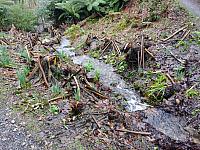As the regular reader will know (Hi Steve – how are you, by the way?), I recently-ish acquired some cheap extension tubes for me camera. These are basically cylinders of metal that move the lens away from the sensor, thereby reducing minimum focussing distance (at the cost of light and depth-of-field).
This enables them to act as a poor-man’s (<10 quid!) macro lens, enabling more than 1:1 reproduction with a full set and a 50mm lens (which happens to be my favourite lens). I’ve already posted some of the pics I’ve taken with them on here.
There are, however, two definite drawbacks to using (cheap) tubes, and one probable drawback.
- No electrical contacts mean you lose aperture control (on most lenses) and auto-focus. This in turn means the lens is
stuck
wide open, leading to - (debatable pro/con) a tiny depth-of-field. Literally millimetres or less. And finally,
- you lose a lot of light, requiring a tripod or flash. Akin to this, they are very susceptible to shake. It also will highlight deficiencies in the lens.
That said, they are really good fun!
Can’t do a right royal lot about the auto-focus (except buy a macro lens, or much more expensive tubes with contacts) – although the general trick seems to be to rock backwards and forwards to achieve good focus.
The good news is that you can do something about the aperture (on a Canon, at least) – you can choose the aperture to shoot with! You have to decide the aperture in advance, but it’s well worth doing.
The steps are as follows:
- Mount the lens on the camera.
- using Av or M modes, dial in the required aperture (f/8 – f/11 seem good choices).
- Press the Depth-of-Field Preview button to stop down the lens.
- with the button still pressed umount the lens – it will remain stopped down.
- Mount it on the tubes, and then both back on the camera.
- Voila – enjoy a sensible DoF for macro work (albeit at the cost of even more light).

